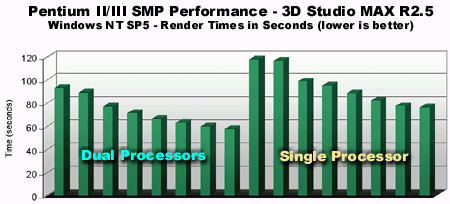Desktop CPU Comparison - September 99
by Anand Lal Shimpi on September 6, 1999 1:23 AM EST- Posted in
- CPUs
When dealing with multi-processor systems, L2 cache size and speed is critical to the performance of the system however L2 cache size, more than speed, is the definitive factor. With the Celeron's 128KB L2 cache weighing in at 1/4 the size of that of the Pentium II/III, applications that aren't manipulating a large amount of data don't notice that great of a performance difference (if any) between dual Celerons and dual Pentium II/IIIs. However, the minute you turn on the complexity, as our 3D Studio MAX render times show below the scene shifts to represent a new point: the smaller L2 cache of the Celeron will prevent it from achieving the same performance when running in multi-processor systems that a Pentium II/III will.

(from left to right) P2-300, P2-333, P2-350, P2-400, P3-450, P3-500, P3-550, P3-600
As you can see here, there is a noticeable increase in performance when going from a single Pentium II/III to a dual Pentium II/III system. Keep in mind that 3D Studio MAX R2.5 is a multi-threaded application, and thus benefits greatly from multi-processor systems. In this case, a dual Pentium II 400 would be faster than a single Pentium III 600. But let's see what happens when we stick in two Celerons instead:

Unlike single threaded business applications, L2 cache speed doesn't matter as much here as does size and thus we get a much more level graph with the Celeron whose 128KB of L2 cache doesn't seem to cut it. Granted the price on two Celerons is much less than the cost of two Pentium II/IIIs, but don't expect to get the same performance out of two Celerons as you would out of two Pentium II/IIIs.










0 Comments
View All Comments